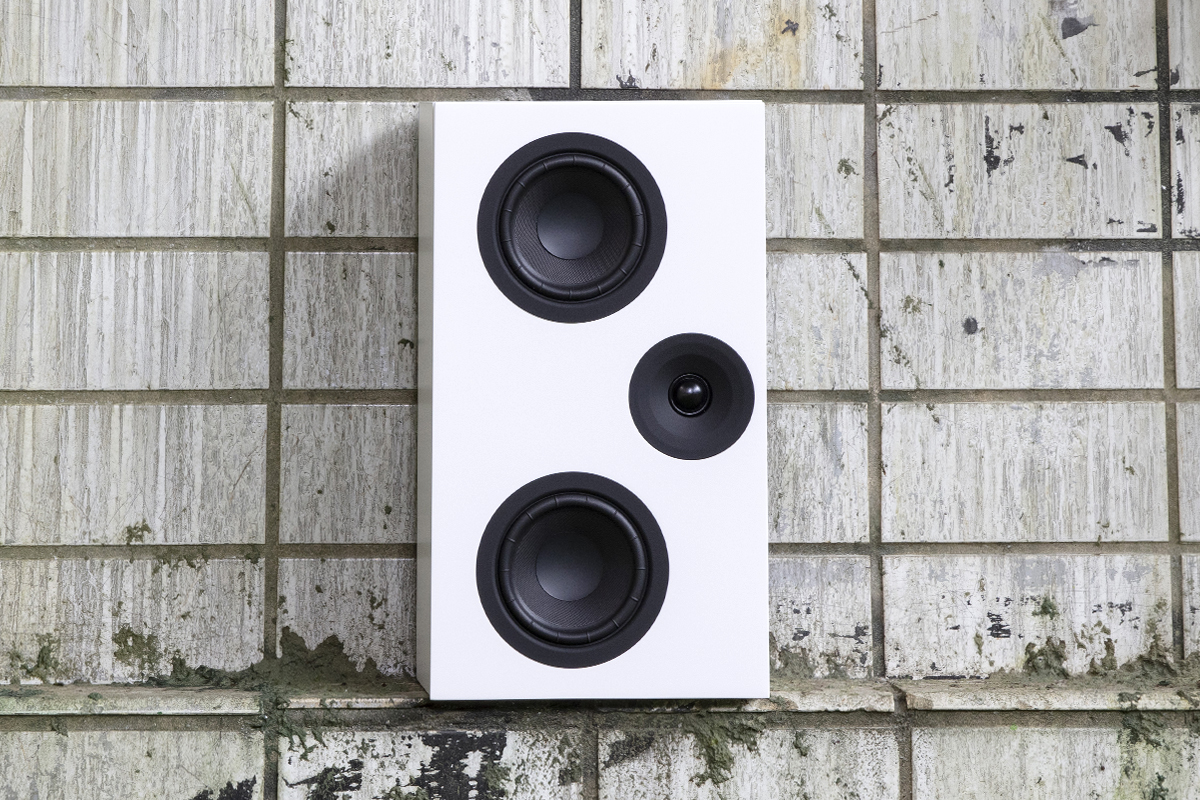Life gets in the way of a lot of things, and sometimes it gets in the way of hi-fi. Audiophiles who have dedicated listening rooms are lucky in this respect; audiophiles who must set up their sound systems in multipurpose spaces can find their hobby conflicts with other activities that go on in those rooms. The speaker locations that might deliver the best tonal balance and soundstaging might be occupied by an armchair or end table. Freestanding speakers might present a tipping hazard for households with rambunctious toddlers or pets.
In-wall speakers are a possible solution. But if the system is being retrofitted into an existing dwelling, this may be impractical. Many homeowners are reluctant to slice holes in their walls and fish cables around studs. In older homes with lath-and-plaster construction, in-wall speakers aren’t a practical solution. And they’re not an option for renters.
But what about speakers that mount on the wall? On-wall speakers are available from many brands, including Denmark’s System Audio, which offers three passive models and one active system, the Legend 7.2 Silverback (€1899 each, including worldwide shipping). The speakers are sold singly, because they can be used in various positions for surround sound as well as stereo applications.
Inside each on-wall Silverback is an electronics module sourced from Platin Audio, a division of Hansong Technology in Nanjing, China. The module incorporates a class-D amplifier for each of the Silverback’s three drivers, a digital signal processor that implements the active crossover, and a WiSA (Wireless Speaker and Audio) radio that receives digital audio from a WiSA-enabled component, such as SA’s Stereo Hub (€399), which is also sourced from Platin Audio. System Audio says a 7.1-channel Surround Hub is under development.
The active design and WiSA capability are what make the Legend 7.2 Silverback so versatile. You can hang the speakers in a location that’s optimal from a sonic standpoint. While you have to provide AC power, you don’t have to string cables back to an equipment stack, as you’d have to do with passive speakers.
The speakers
SA’s Legend 7.2 Silverback speakers can be oriented horizontally or vertically to suit different rooms and applications. For example, when used as a center-channel speaker in a surround-sound setup, it would usually be desirable to orient the speaker horizontally. In many two-channel applications, it will be preferable to orient the speakers vertically.
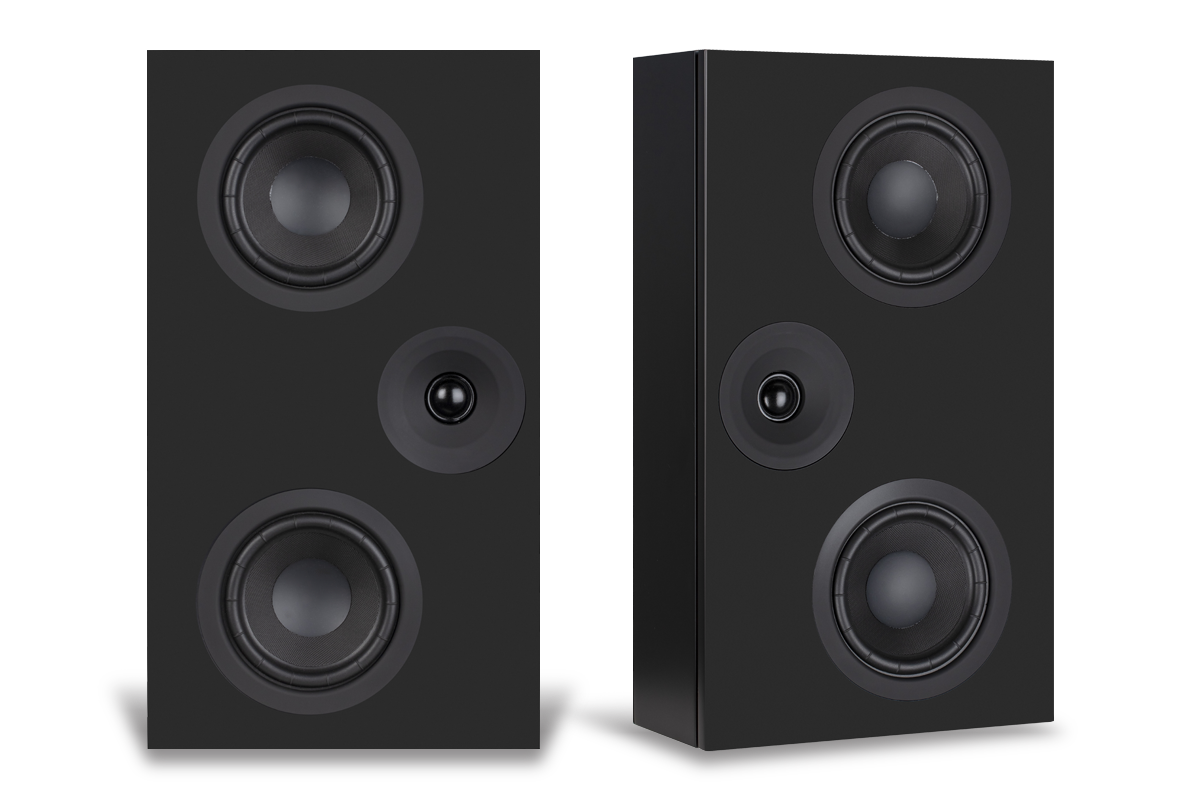
The on-wall Silverbacks are available in satin finishes of white and black. Each speaker comes with two magnetically attached grilles: one for vertical orientation, the other for horizontal. Two observations: I found the white finish of my review sample quite cool and bright—fine for modern decors, but less suitable for rooms with warm tones. Also, the magnets are rather weak, so the grilles are easily dislodged.
The speaker cabinet is tapered—it’s slightly wider and taller at the back than at the front. At its tallest and widest points and oriented vertically, the speaker measures 18.5″H × 11.3″W × 6.1″D.
Along one long edge of the front baffle are two 5.3″ woofers with woven carbon-fiber cones. In the middle of the opposite long edge is a waveguided 1″ silk-dome tweeter. According to System Audio, the long excursions of the woofer cones enables them to move 40% more air than typical woofers of this size. Along with the 6dB of room gain provided by on-wall placement, that enables the Silverback to deliver surprisingly deep bass. Specified frequency response is 30Hz–25kHz, ±1.5dB.
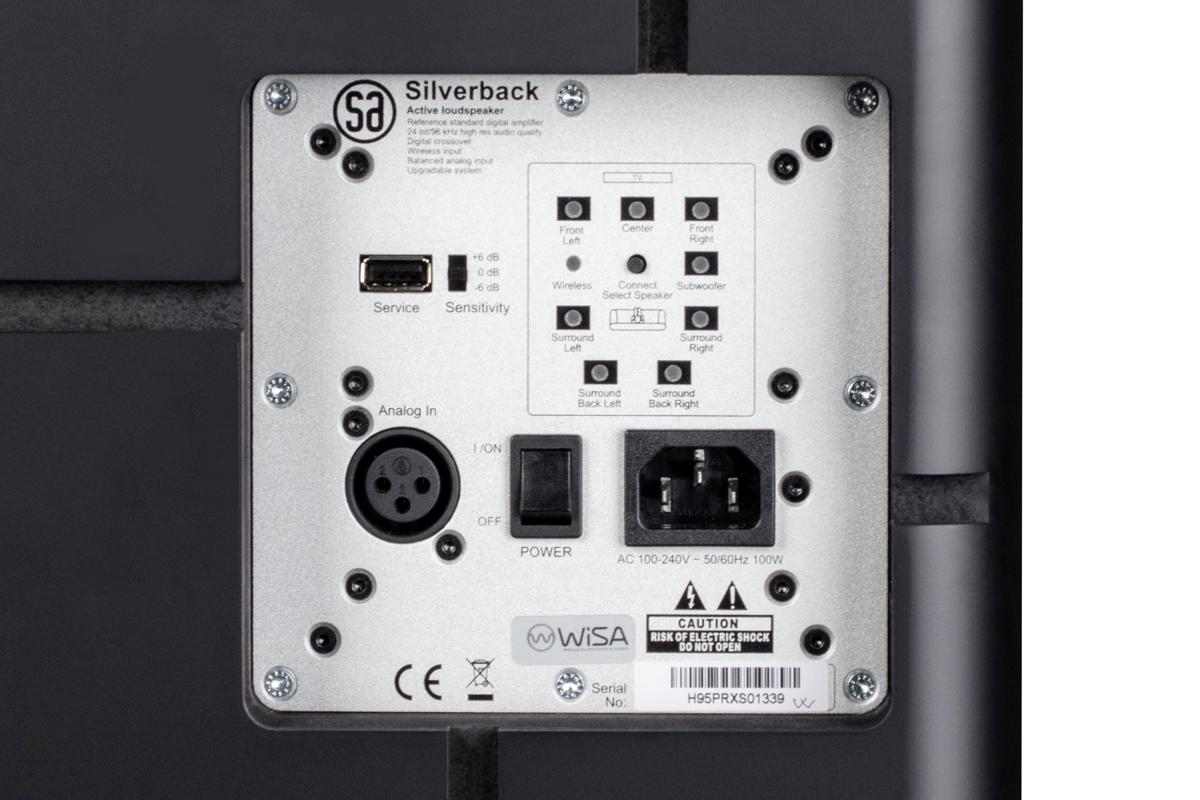
The Silverback module on the rear panel houses the WiSA receiver, an Analog Devices DSP, and three Texas Instruments power DACs that can deliver 75W to each driver, for a total of 225W. From left to right at the bottom of the module panel are a balanced analog input (XLR), a rocker power switch, and the power inlet. Above the analog input are a USB Type-A service port for firmware upgrades, and a slider switch with settings of +6, 0, and -6dB for adjusting the speaker’s sensitivity with an analog connection. Above the power inlet and rocker switch is a panel showing a map of possible speaker/channel positions, and a button for choosing among these and pairing the speaker with a WiSA transmitter.
On other SA active speakers, such as the Legend 40.2 Silverback floorstander ( €4999/pair), the USB port can be used for loading different DSP programs, which SA calls RAM Tweaks, that reconfigure the active crossover. At this point, there are no alternative RAM Tweaks for the Legend 7.2 Silverback, System Audio founder Ole Witthøft told me in an email exchange, but some may be released in the future.
On the back of the enclosure are six keyhole inserts for wall-mounting the speaker, vertically or horizontally. There are also channels for routing the AC cord from the electronic module’s three-prong AC inlet. SA supplies a right-angle adapter for the AC cord and small rubber feet for mounting the speakers against the wall. But the speakers can also be placed on a shelf, System Audio says.
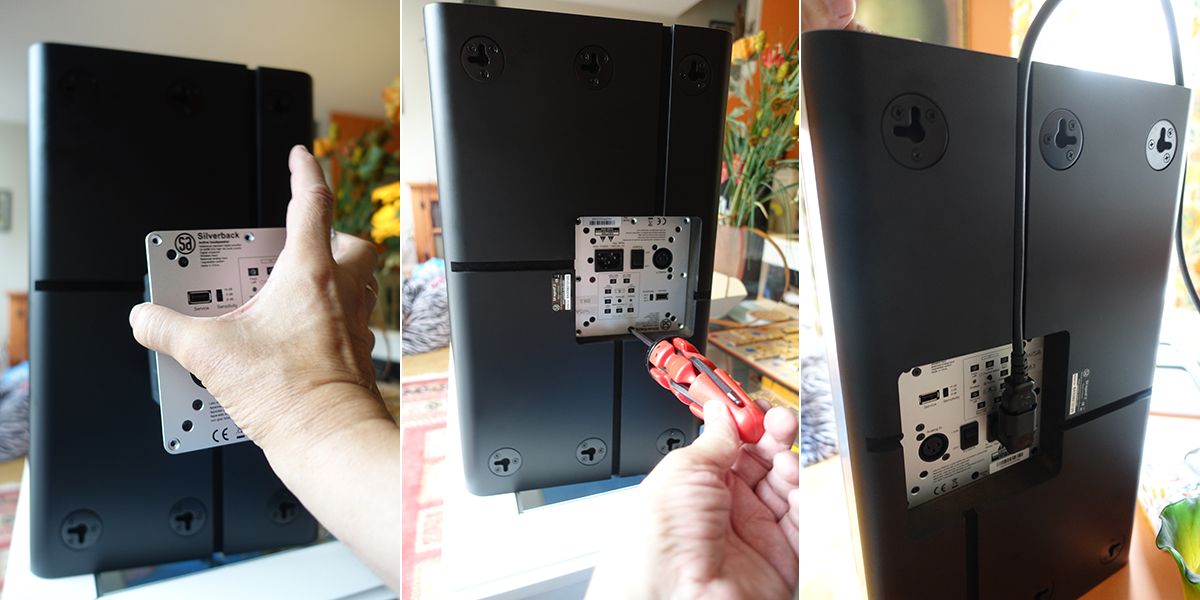
Out of the box, the Legend 7.2 Silverback is configured for vertical orientation. To switch to horizontal orientation, or to change the placement of the tweeter from top to bottom (in a horizontal setup) or inside to out (in a vertical setup), remove the Silverback electronic module, reorient it so that the AC inlet is above the correct wiring channel, and then screw it back in. No big deal—this is dead easy.
This clever industrial design allows for a very clean installation. Mount the speaker on the wall with the module and AC cord oriented appropriately, then cover the AC cord with some paintable conduit. Genius!
The Stereo Hub
The Stereo Hub is a silver-colored metallic box measuring 6.7″W × 1.7″H × 3.9″D—small enough to stash away in a small cabinet, completely out of sight. Along with the WiSA transmitter, the Hub has Wi-Fi and Bluetooth connectivity. It supports Apple AirPlay, Google Chromecast, Spotify Connect, and UPnP/DLNA. Roon Ready certification is pending, Witthøft told me.
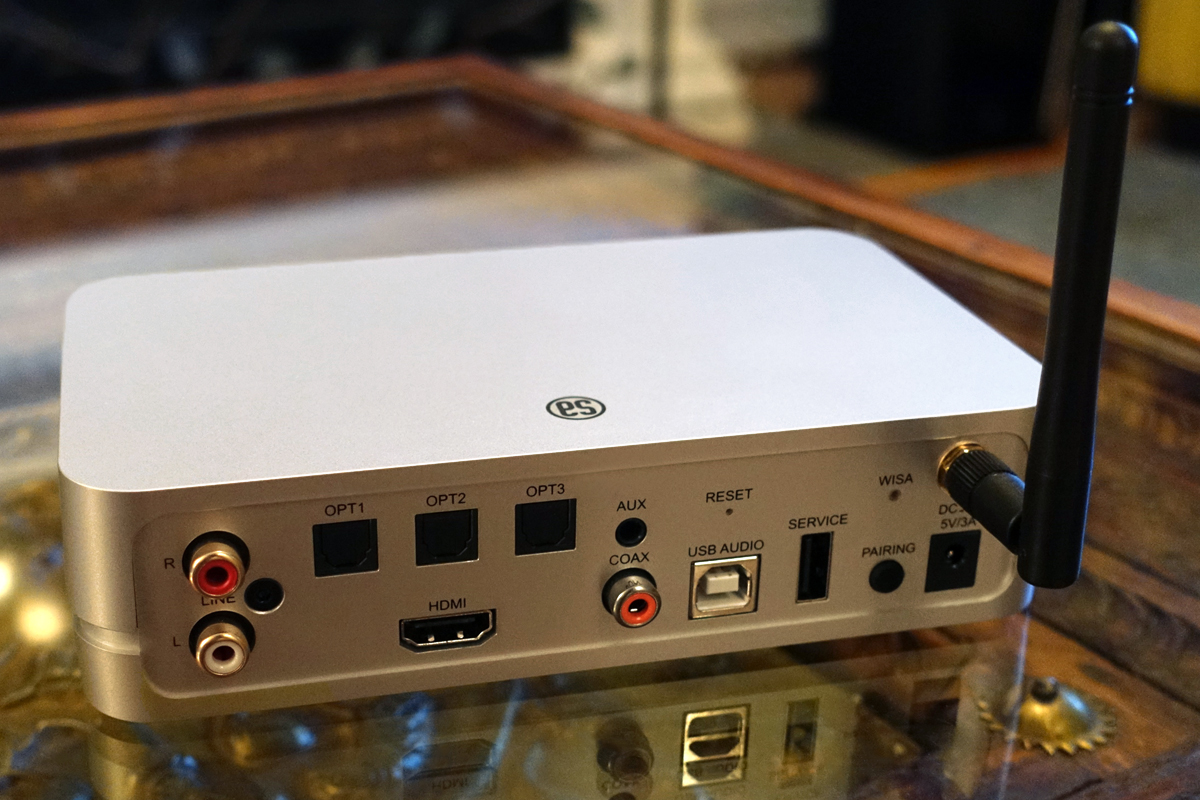
On the rear of the Stereo Hub are one coaxial (RCA) and three optical (TosLink) S/PDIF inputs, a 3.5mm combined analog/optical digital input, a pair of single-ended analog inputs (RCA), an HDMI ARC input for connection to an HDTV, and a USB Type-B port for connection to a PC or Mac, plus a button for pairing the Hub with the speakers and the supplied remote.
The Stereo Hub’s maximum resolution via coaxial, optical, and USB connection is 24-bit/192kHz. When streaming via Wi-Fi using Chromecast or UPnP, maximum resolution is 24/96. Apple AirPlay supports streaming at 16/44.1.
System Audio offers a free room-correction app, SA Room Service, that works with the Stereo Hub. Choose Room Calibrate in the opening menu, then walk around your listening room while the app plays pink noise through the speakers. After one minute, the app will create a profile of your room’s acoustics and offer to transfer a calibration filter to the Stereo Hub. You can enable and disable room correction via the Room Service app.
In the past year, the company has rolled out a new app, called SA Cockpit, that includes Room Service calibration, WiSA speaker setup, and an equalization function with three presets. Each preset can include a combination of low-shelving, high-shelving, first-order high-pass and second-order high-pass filters, and parametric EQ. The EQ function operates on both channels—you cannot apply different EQ curves to the left and right speakers.
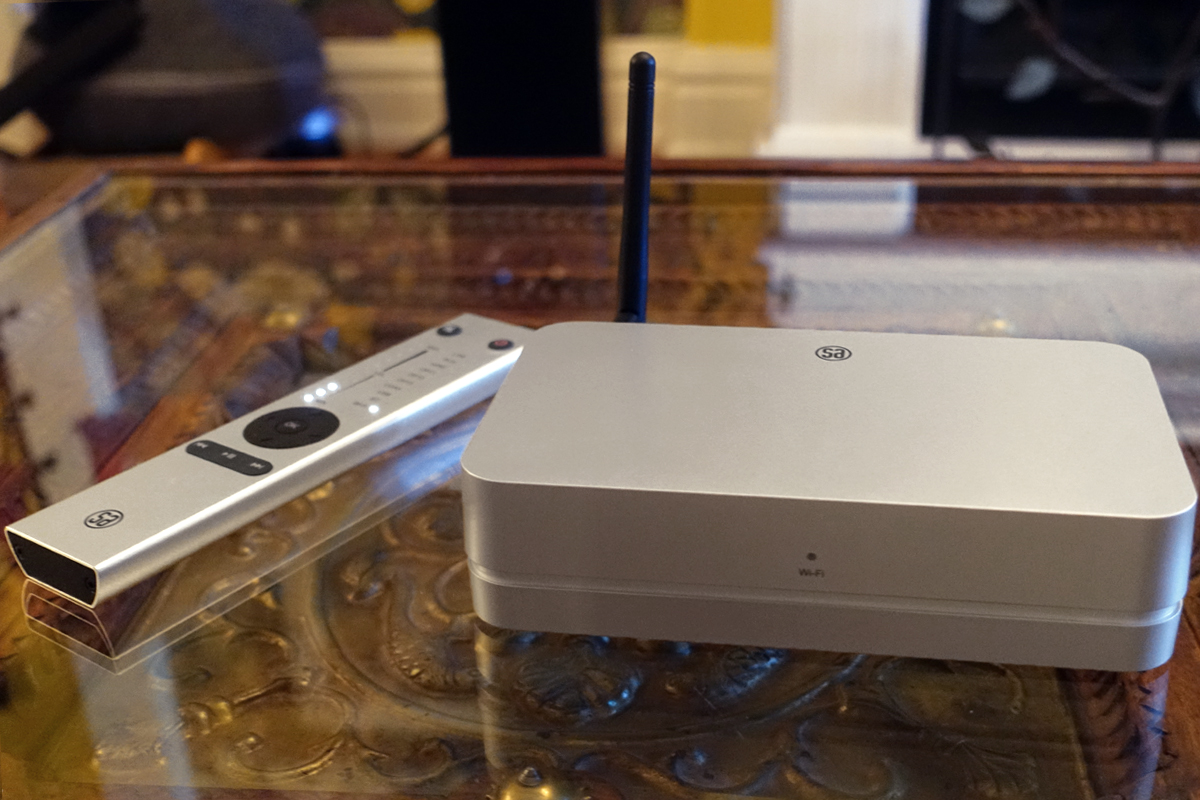
The metal two-way RF remote has a nice solid feel. Functions include source select, volume, mute, on/off, and track-skip. Two columns of LEDs indicate the volume and selected source.
Setup and software
I set up the Silverbacks in the basement family room of our vacation home in Southampton, Ontario. Not wanting to drill holes in the walls for this project, I placed the speakers on 28″ Monoprice Monolith speaker stands. The speakers were 8′ apart with their backs right against the wall, just as they would have been had I wall-mounted them. The tweeters were exactly at ear level as I sat in my listening chair, 10′ away. I oriented the speakers vertically, with the tweeters on the outside, so that the soundstage would be as broad as possible. I described my layout to Witthøft in an email exchange, and he agreed that this orientation suited my room layout.
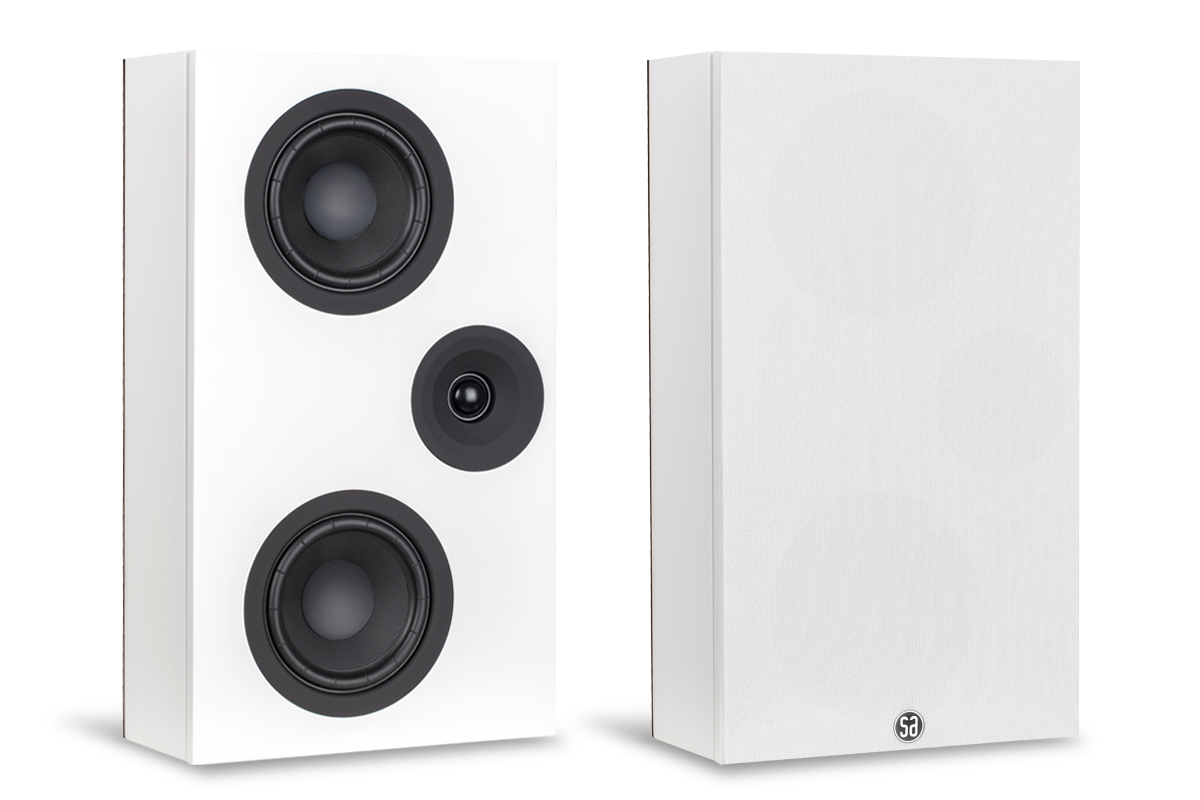
After that, the next order of business was to set up the Stereo Hub. Pairing the Hub with the speakers was a breeze. Per the Quick Guide, I pushed the Connect buttons on the back of the two speakers and then the Pairing/Connect button on the Hub, and I was done. You can also change the channel designations of the speakers by pushing the Connect button until the LED for the channel you want is illuminated.
But I ran into a snag connecting the Stereo Hub to my Wi-Fi network, which you do using the Google Home app. When I launched Google Home on my Google Pixel 4a 5G smartphone, an option to set up the Stereo Hub appeared at the top of the main screen. So far, so good. But when I selected that option, I got a screen stating, “Stereo Hub found. It needs to be activated before setup,” with a button at the bottom of the screen labeled “Go to Help Center.”
The Help Center instructed me to download and run Google’s Device Utility app. That app directed me to turn off Wi-Fi in the Android settings menu then return to the app. The app displayed a screen “Looking for Devices,” and a couple of minutes later, displayed another screen, “Make sure the device is powered on and near your phone.” The Stereo Hub was on, and my phone was very close to the Hub. I could go no further.

Until recently, I’d never run into problems setting up Chromecast-capable devices using Google Home, but I’ve now had similar experiences with two other products. In one recent review, I was directed to use the Device Utility app, after which I was able to complete setup. After I completed the Silverback review, I experienced the same issue with a Q Active 200 speaker system and Q Active Hub. I had had to reset the Q Active Hub, and when I attempted to set it up again with Google Home, I ran into the same roadblocks I experienced with the SA Stereo Hub. That didn’t happen when I first set up the Q Active system a year ago. I strongly suspect that something Google has done with the most recent versions of Google Home or the Android OS is causing this problem. When I used the Google Home app on my iPhone 8 to set up the SA Stereo Hub and the Q Active Hub, setup proceeded without a hitch. Go figure!
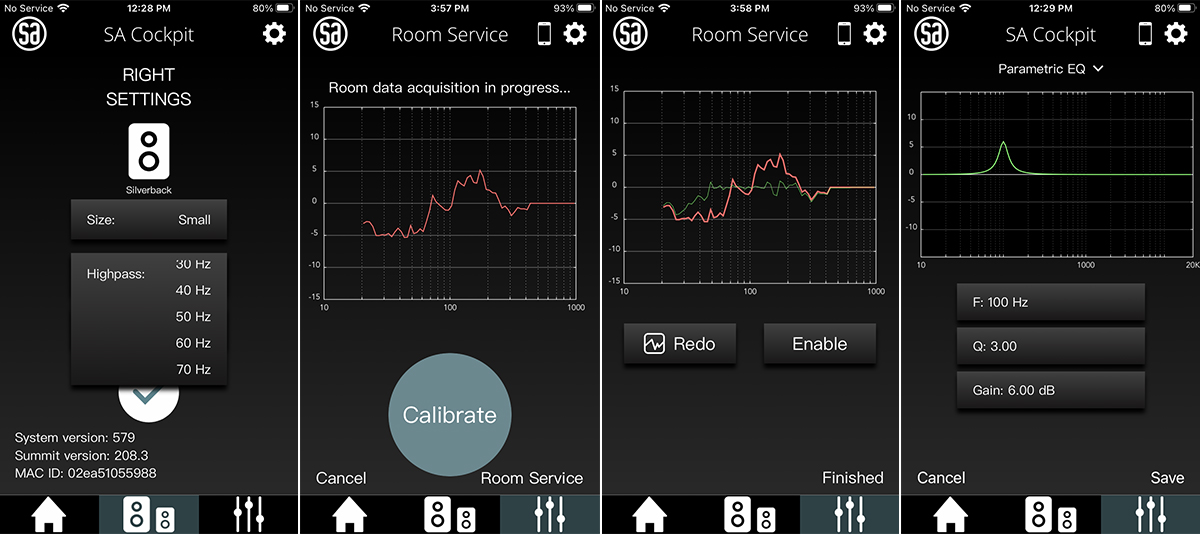
After connecting to Wi-Fi, you can customize your WiSA setup with the SA Cockpit app. A signature feature of this app is Room Service room correction. But as I had experienced a year ago when reviewing SA’s Legend 40.2 Silverback active floorstanders, I couldn’t get the Room Service feature to work. After performing Room Service calibration, I heard no difference when I enabled and disabled the feature. However, I did hear a difference when I enabled parametric EQ filters. I did all my listening for this review with Room Service disabled, and with no EQ filters.
Listening
During the review period, I streamed music to the Stereo Hub and on-wall Silverbacks from my iPhone 8 via AirPlay and from my HP Spectre x360 convertible notebook PC via UPnP. But for most of my listening, I streamed music from the Qobuz app on my Google Pixel smartphone to the Stereo Hub via Chromecast. I experienced a few dropouts, but these were rare. Most of the time, music played with no hiccups at all.
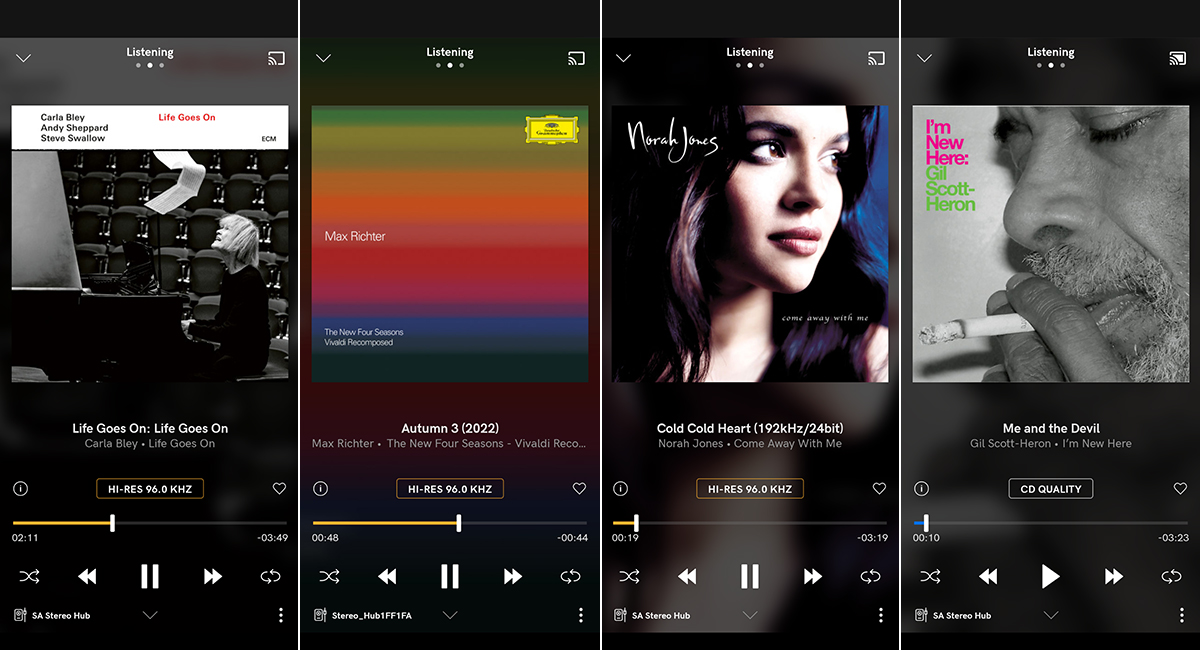
Could these active on-walls reach down to 30Hz, as SA claims? They sure could, as I confirmed by playing the titular suite from Life Goes On by Carla Bley, Andy Sheppard, and Steve Swallow (24-bit/96kHz FLAC, ECM / Qobuz). Swallow, Bley’s husband, plays a five-string electric bass, whose lowest string is tuned to B0, about 31Hz. Bass notes were impressively powerful through the whole range of his instrument, including riffs played on the bottom string. While pitch differentiation was very good, the lowest notes were somewhat lacking in texture, so that it was hard to hear Swallow’s plucks. But on the middle and upper strings, the Silverbacks were very articulate.
Bley’s piano sounded wonderful through the Silverbacks. Bass and midrange notes had impressive authority. The active Silverbacks nailed Bley’s playful touch—I could hear her subtle attacks decaying naturally into the resonance of the instrument’s soundbox. The Silverbacks scaled up effortlessly to reproduce Sheppard’s toots on tenor and soprano saxophones. Both instruments had a ripe, reedy tone, without sounding excessively squawky. As they did with Bley’s piano, the Silverbacks portrayed Sheppard’s technique beautifully, making it easy to hear the various ways he blew into his instruments.
Lateral imaging was very precise. The soundstage was deeper than my eyes led me to expect. When I closed my eyes and just listened, it was clear that the soundstage extended a little beyond the front wall, and Sheppard’s saxophones were actually in front of the speaker plane. Throughout this piece, the on-wall Silverbacks sounded bigger and more powerful than I’d expect from speakers that size.
Summer was coming to a close while I was conducting this review. To mark the change of seasons, I cued up “Autumn 1” from The New Four Seasons: Vivaldi Recomposed by Max Richter (24/96 FLAC, Deutsche Grammophon / Qobuz), performed by the Chineke! Orchestra and solo violinist Elena Urioste. On this recording, the orchestra and soloist play period instruments with gut strings, and Richter plays a 1970s Moog synthesizer.
The massed strings at the beginning of “Autumn 1” and throughout “Autumn 3” sounded wonderfully transparent. Through the Silverbacks, it was easy to hear the action of the bows on gut strings in orchestral passages and in Urioste’s solo passages; but string tone was never edgy. In the delectable, tender passage halfway through “Autumn 1” and throughout the fugal “Autumn 3,” I was wowed by how deep and powerful Richter’s bass lines on the Moog sounded. While these notes had a slight droning quality, pitch differentiation was spot-on. At the opposite end of the tonal range, the Silverbacks produced a lovely glassy tone on the high notes in the harpsichord solo at the beginning of “Autumn 2,” and articulated the rolled chords beautifully. Lower notes on the harpsichord sounded gorgeous, with glassy attacks decaying into the resonance of the instrument’s soundbox.

While I found the Silverbacks’ rendition of the deepest notes of Swallow’s five-string bass and Richter’s Moog synthesizer a bit indistinct, I loved the way they delivered Lee Alexander’s double bass in “Cold Cold Heart,” Norah Jones’s cover of the Hank Williams song from her debut album Come Away with Me (24/192 FLAC, Blue Note / Qobuz, downsampled to 24/96 for playback via Chromecast). Emerging from the left side of the soundstage, Alexander’s instrument had a deep, woody resonance, with delicious snap on the upper strings. As Alexander descended to the lowest note on his instrument (E1, 41Hz), the sound became a tiny bit bloated, and its location on the soundstage became vaguer.
As to the Silverbacks’ sound higher in the audioband, it was almost magical. Jones’s slightly wispy voice, locked in the center of the soundstage, sounded ideal. Consonants were clear but not spitty or hot. The Silverbacks delivered every expressive nuance—the way Jones draws out some vowels and modulates levels to make an expressive point—clearly, but without exaggeration. It was as if she was in the room. The sound of Jones’s piano, just to the right, was equally convincing, with satisfying heft in the lower octaves and lovely ringing clarity in the middle and upper octaves, and no hint of clanginess. Through the Silverbacks, I could easily admire Jones’s creative pedaling and varied touch. Closing my eyes, I could visualize the way she changed pressure on the keys as she moved from legato to staccato.
For something more intense, I cued up Gil Scott-Heron’s cover of “Me and the Devil” from his extraordinary album I’m New Here (16/44.1 FLAC, XL Recordings / Qobuz). The startling rat-a-tat effects and manic handclaps jumped out of the Silverbacks with no sense of strain. The deep, descending synth line sounded loud and powerful, with good pitch differentiation, but was a little boomy in the lowest notes. Similarly, the hip-hop drumbeats were huge and powerful, but a bit thuddy. However, these are just minor quibbles. These bass sounds are what give the song its power, and the Silverbacks delivered. Where they excelled was in the reproduction of Scott-Heron’s raw, bluesy baritone—every snarl, every rasp was delivered with amazing clarity. This song is meant to scare the bejeezus out of the listener, and through the Silverbacks, it did.

To assess the on-wall Silverbacks’ performance with movies, I connected the Stereo Hub to the HDMI ARC port of a Philips 32″ Android TV and streamed episode 1 of Amazon Prime’s Lord of the Rings prequel The Rings of Power via Chromecast. When I turned the TV on, the Stereo Hub automatically switched to the HDMI input.
In the opening sequence, Bear McCreary’s musical soundtrack sounded lovely, with silky string tone and burnished brass; but the big timpani rolls were a tad thuddy. Dialog between the young Galadriel (Amelie Child Villiers) and her brother Finrod (Will Fletcher) sounded completely natural. The ensuing battle sequence in Middle Earth sounded appropriately terrifying. Big low-frequency effects like crashing thunder sounded huge and powerful, but a little thuddy.
Comparison
I compared the Silverback on-walls with Buchardt Audio’s A500 WiSA-compatible active standmount speakers (€3500/pair in standard finishes, €3650/pair in walnut, including worldwide shipping). The A500 also employs a WiSA amplifier module manufactured by Platin Audio, and works with Buchardt’s Stereo Hub, which is identical to SA’s. The driver complement comprises front- and rear-mounted 6″ paper-cone midrange-woofers and a waveguided 0.74″ fabric-dome tweeter, each powered by a class-D amplifier rated at 150W RMS/300W peak. Just as SA does with its RAM Tweaks, Buchardt offers different Mastertunings for changing the A500’s DSP-based crossover. I used the default 2.5-way Mastertuning for this comparison.
Overall, I was really impressed with how well the System Audio Legend 7.2 Silverback held up against the Buchardt A500, which won a SoundStage! Network Product of the Year Award in 2020.
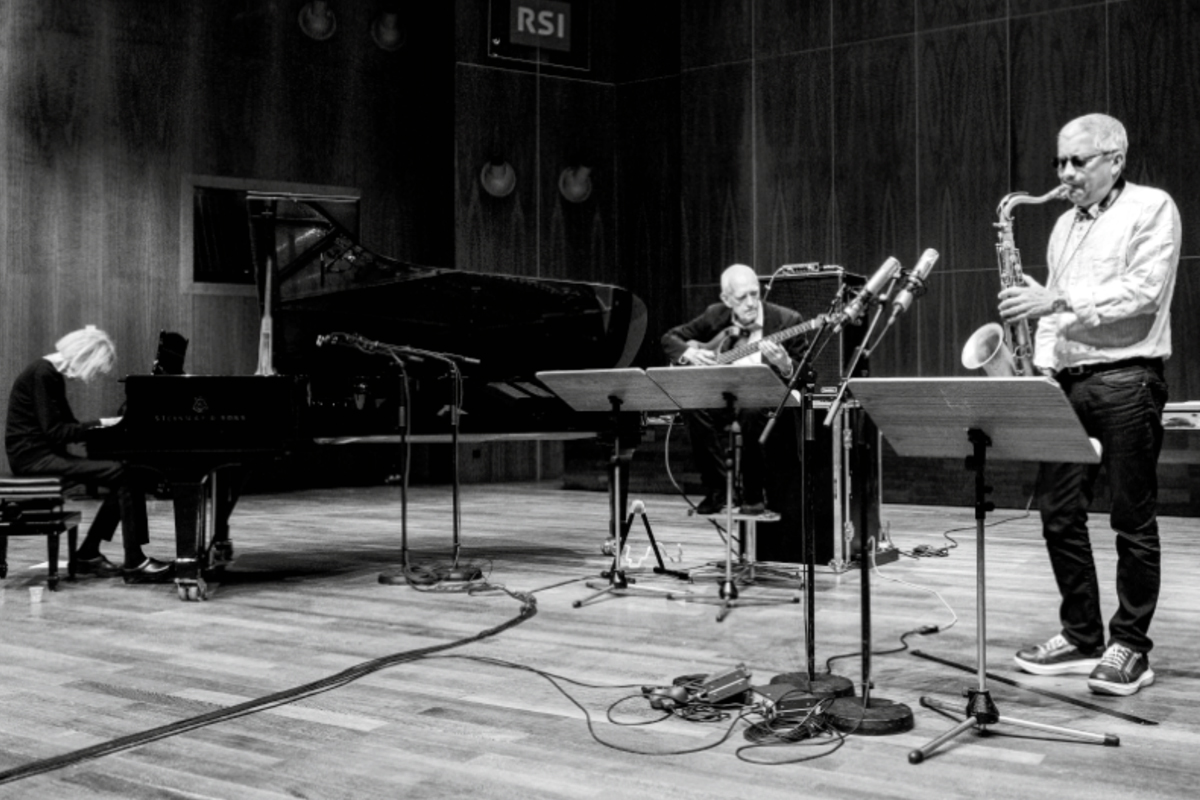
On Life Goes On, Bley’s piano attacks sounded a bit more precise through the Buchardts, so I was more aware of her skipping, sashay touch. But through the Silverbacks, piano tone was richer, and I heard more of the resonance of the soundbox. Similarly, Swallow’s plucks on the upper strings of his five-string electric bass guitar were sharper on the A500s. While the lower notes didn’t sound as powerful as they did through the Silverbacks, they were better defined. Through the A500s, I could hear Swallow’s plucks on the bottom string much more clearly than I could with the Silverbacks. With the A500s, Sheppard’s saxophones sounded a little reedier and squawkier, and not quite as full as they were through the Silverbacks. The spatial presentation was a little flatter with the Silverbacks compared to the A500s, but the Silverbacks’ sound was a bit bigger and more powerful.
On The New Four Seasons, the period violins had more bite when played through the Buchardts, so that I could hear more of the action of the bows on the strings, but they also sounded edgier—string tone was sweeter on the Silverbacks. Richter’s bass lines on the Moog synthesizer were more pronounced on the Silverbacks, but more textured and less drony on the Buchardts. Overall, the Silverbacks sounded fuller and more natural, while the Buchardts sounded more spacious and transparent, with more dramatic dynamics. Front-to-back layering was better on the Buchardts.
With the LOTR: The Rings of Power, the Buchardts threw a wider, higher soundstage. Big low-frequency effects like crashing thunder sounded just as deep and powerful as they did through the Silverbacks, but had better definition. In a scene inside an abandoned evil fortress, the way sounds echoed through the caves was more palpable through the Buchardts. The pounding timpani had better definition through the A500s. Dialog was just a tad crisper through the Buchardts, but voices were a tad fuller and more embodied through the Silverbacks.
Conclusion
I’ve raised some criticisms about the SA Cockpit app, particularly about the ongoing problems I’ve had in getting Room Service room correction to work. (BTW, the same criticisms apply to the Buchardt app. Both apps were developed by Platin and operate identically.) There was also the weirdness I experienced trying to set up the Stereo Hub with the Android version of Google Home. As noted above, I think Google, not SA or Platin, is the cause of this bug. Hopefully, it will be fixed soon. In the meantime, the iOS version of Google Home can be used to set up the Hub. Neither of these issues would be a dealbreaker for me.
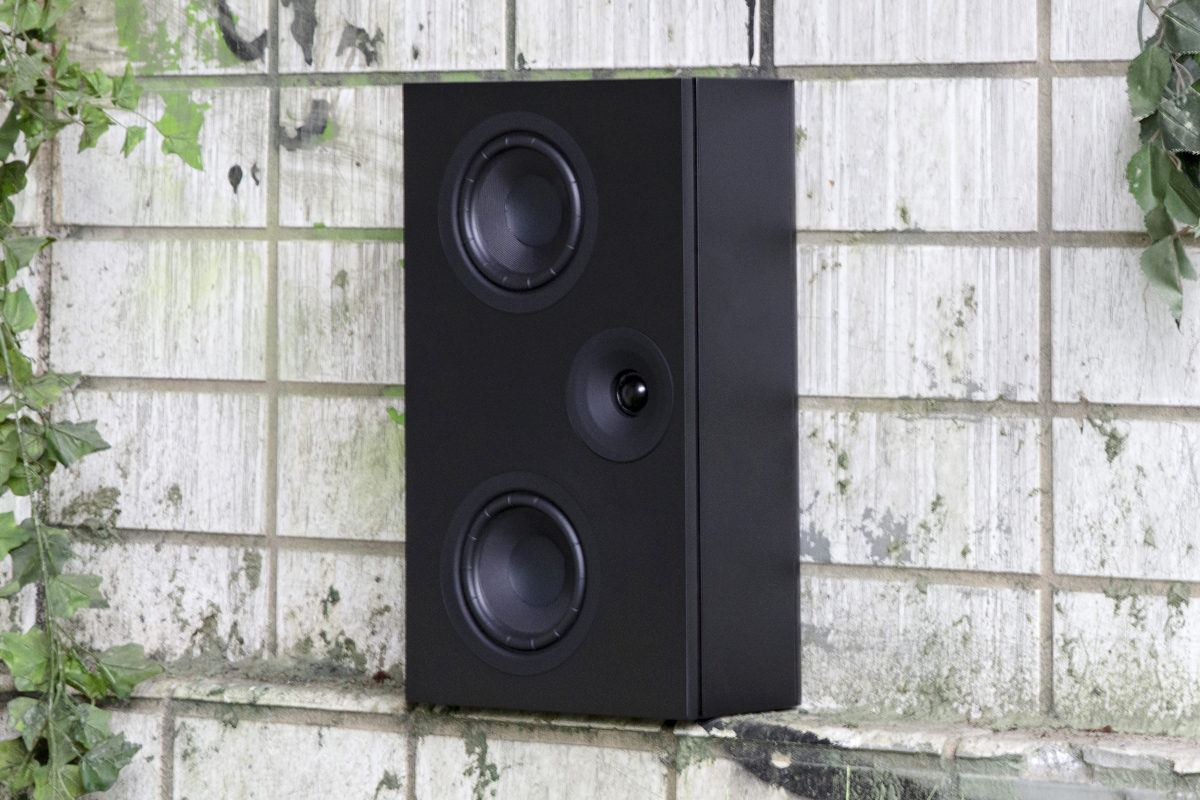
As to the sound of the Silverback active on-wall speakers, I have very few reservations. I have mentioned a lack of texture in very deep bass frequencies. This affected bass definition but not differentiation of tone. From the midbass up, the Silverback’s performance was excellent.
System Audio’s headline for the Legend 7.2 Silverback is bold: “The impossible has become possible.” That might seem hyperbolic at first, but not when you think about it a little. I suspect that there are many people who would love to have an audiophile-grade music system (or maybe even a surround system) in a multipurpose living space, but find it impossible because of room layout. For them, the Silverback active on-wall speakers might be just the ticket.
. . . Gordon Brockhouse
Associated Equipment
- Active speakers: Buchardt Audio A500 and Stereo Hub.
- Speaker stands: Monoprice Monolith (28″).
- Sources and control devices: Apple iPhone 8 and Google Pixel 4a 5G smartphones, HP Spectre x360 convertible notebook PC.
- Display: Philips 32PFL5505 32″ Android TV.
- Network: Hitron CODA-4582 DOCSIS 3.1 internet gateway.
System Audio Legend 7.2 Silverback Active Loudspeakers
Price: €1899 each.
System Audio Stereo Hub
Price: €399.
Warranty: Seven years, parts and labor; two years, parts and labor for electronics.
System Audio A/S
Langebjerg 35A
4000 Roskilde
Denmark
Phone: +45 36 45 80 80
Email:
Website: www.system-audio.com



